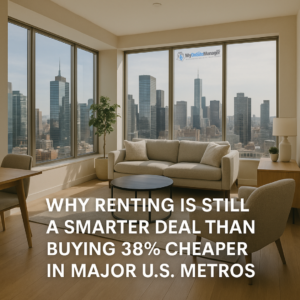For decades, the American dream has been synonymous with homeownership. But in 2025, new data from Bankrate shows that in most major U.S. cities, renting has become the far more cost-effective option saving the average household thousands of dollars a year compared to buying.
The Numbers Tell the Story
Bankrate’s latest analysis compared the cost of renting a typical apartment to buying a median-priced home in the 50 largest metropolitan areas across the United States. Their findings reveal a striking gap:
-
38% Savings When Renting: On average, renters spend $1,027 less per month than homeowners with a mortgage.
-
Average Costs: Buying a home comes with a median monthly payment of $2,768 (including mortgage, taxes, and insurance), while renting a comparable property costs roughly $1,741.
-
Widening Gap: In 38 of the 50 metros studied, the rent-vs-buy gap has grown compared to last year, signaling that ownership is becoming even less affordable.
Cities Where Renting Makes the Biggest Difference
The cost advantage of renting is most pronounced in high-priced, tech-driven markets, where home values have soared over the past decade:
-
San Jose, CA – Home to Silicon Valley, buying costs are 165% higher than renting.
-
San Francisco, CA – Still one of the most expensive markets, despite price dips.
-
Seattle, WA – Another tech hub where renting can save residents hundreds or even thousands each month.
Meanwhile, some Rust Belt and Midwest cities tell a different story. In places like Detroit, Philadelphia, and Cleveland, the monthly cost difference between renting and buying is far smaller, sometimes making ownership more achievable.
Why Renting Is Winning in 2025
Several economic and housing market forces are driving this trend:
-
High Mortgage Rates: Even though rates have cooled slightly from 2023–2024 highs, they remain around 6%–7%, significantly increasing monthly payments.
-
Persistent Home Price Growth: Inventory shortages have kept prices elevated, particularly in coastal metros.
-
Slower Rent Growth: In many markets, rental prices have plateaued or even dropped slightly over the past year.
-
Upfront Costs of Buying: Down payments, closing costs, and maintenance expenses make ownership harder to justify for those without substantial savings.
The Case for Renting
Renting isn’t just about lower monthly costs it also offers:
-
Flexibility: Easier to relocate for work, lifestyle changes, or family needs.
-
Lower Risk: No exposure to housing market downturns or major repair bills.
-
Cash Flow Freedom: More disposable income for investments, travel, or debt repayment.
The Case for Buying
Despite current cost disadvantages, homeownership remains appealing for those who can afford it:
-
Equity Building: Over time, mortgage payments build personal wealth.
-
Stability: Fixed-rate mortgages provide predictable housing costs.
-
Tax Benefits: Mortgage interest and property tax deductions can help offset expenses.
In lower-cost regions, the numbers can even tilt in favor of buying especially for those planning to stay long-term.
What This Means for You
The decision to rent or buy isn’t purely financial it depends on lifestyle, career plans, and personal goals. In 2025, however, the financial scales in most big cities are tipping toward renting.
For prospective buyers, this could mean taking more time to save for a down payment, watching interest rates closely, or considering alternative markets where the gap is smaller. For renters, it’s an opportunity to secure favorable lease terms while ownership costs remain high.
Source: “Renting Increasingly Cheaper Than Buying in Most Large U.S. Metros” – ROI-NJ (April 23, 2025)

